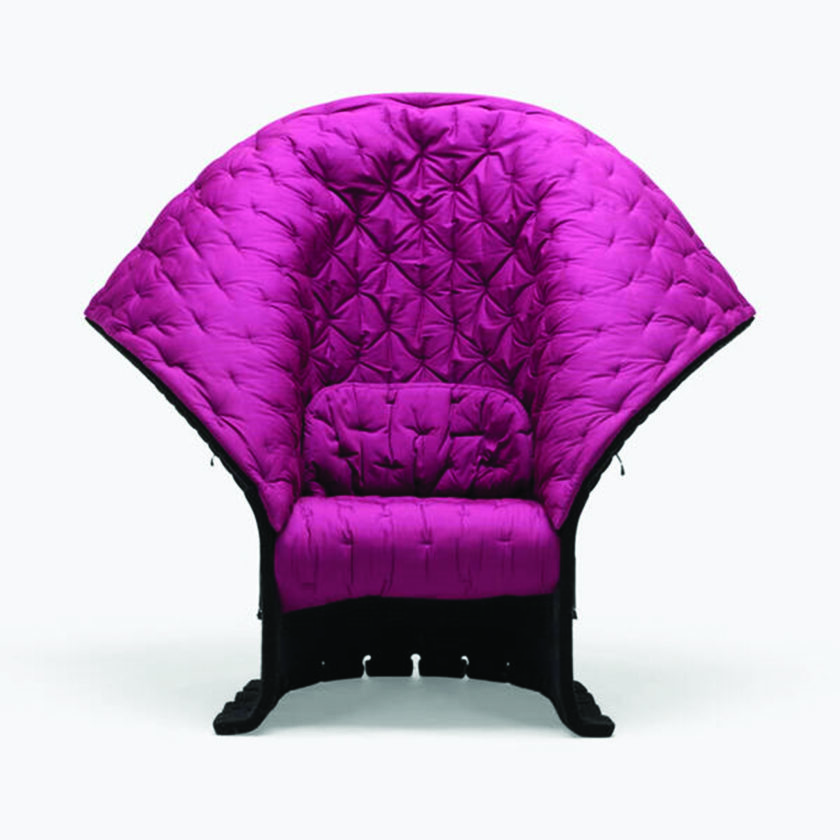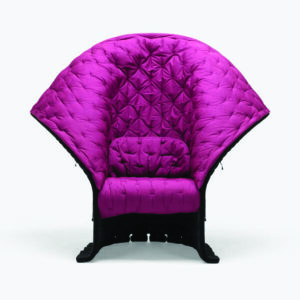Postmodern furniture still commands fascination, price points

Postmodern furniture is a parade of quirky styles and colors, unexpected shapes and materials, and innovative construction. Few designers are more quirky, colorful, or creative than Gaetano Pesce.
Like many of the great 20th-century designers, Pesce (1939-2024) trained as an architect and designed lamps, jewelry, other home furnishings, furniture, and buildings. He is known for his clever work with resin and extruded plastic, but his creative output has a softer side, too. His most famous furniture design might be the UP-5 chair, also called “La Mamma” for its curvy, feminine shape, with fabric upholstery over foam and rubber. The soft foam used in the UP chairs allowed them to be compressed flat for easy packaging, shipping, and storage. They sprang back into shape when the package was opened.
The Feltri chair, which Pesce designed in 1987 for Italian company Cassina, is another one of his famous upholstered designs. As its name may suggest, its base is made of felted wool. Its tufted upholstery may give it a slightly more conventional, even old-fashioned, look than Pesce’s usual work, but his playful, experimental approach to form and function is clearly there. The soft, pliable back and sides of the chair can be folded into different configurations. The Feltri chair has been made in many colors. This vibrant purple vintage Feltri chair sold for $3,696 at Wright.
——
Q: My Hummel ornament with two angels, one playing a stringed instrument, has an unusual mark that I have been unable to identify. It looks like part of the TMK-2 Full Bee, with a bee over the “V” and “(R)” to the lower right. The number “146” and “M.I. Hummel” in script are impressed underneath. I cannot find any reference to the “(R)”. Is it possible to enlighten me as to its meaning?
A: The “(R)” stands for “Registered.” It is unusual, but it does not affect the meaning of the mark or the value of the figure. There are some variations of Hummel marks, especially in the earliest (pre-1970s) marks. According to mihummel.org, the “R” is most often seen in figures dating from 1950 to 1955. TMK-2 Full Bee, the first Hummel mark to feature the bee over a “V,” was used from about 1940 to 1959. Later marks use a stylized bee over the “V” or do not have a “V.” Most Hummel figurines are impressed with “M.I. Hummel,” for designer Sister Maria Innocentia Hummel, and an identification number. Based on the number and your description, yours is the “Angel Duet” baptismal font.
——
Q: I bought a collection of interesting old, framed prints. When I took them out of the frames, the edges were uneven, like they had been cut with scissors, and some of them didn’t have any information about the artist, title, or publisher. Is there any way to identify them?
A: When prints are trimmed, like yours were, they are harder to identify, but it is still possible. One way is to consult an art museum or gallery in your area. They are the experts, and some have events where they provide free identification or appraisal to the public. Some antique prints are copies of famous paintings. If you would rather research on your own, art museums and libraries in your area may have books on the history of printmaking or online resources to help you identify yours.
Some prints can be fairly easily dated by details like people’s clothing or transportation methods. Many of the most popular collectible prints date to the late 19th to early 20th century. These include Japanese woodblock prints (ukiyo-e), American and English prints of the Arts & Crafts period, and advertising prints.
New printmaking and mass-production techniques developed about this time made prints extremely popular in advertising. In addition to hiring popular artists and illustrators like Andrew Wyeth and Marc Chagall to create art for print advertisements, many companies gave away prints or calendars as premiums.
If you believe you have prints from this time period, you may want to look into the history of advertising or contact a club like the Antique Advertising Association of America (pastimes.org) or the Ephemera Society (ephemerasociety.org). About the same time, artists of the Arts & Crafts movement produced woodblock prints in opposition to the commercialization of art. However, remember that prints are easily reproduced. The design for your print may date to the 19th century, but the print itself may have been made much later, especially if it is trimmed.
——
TIP: Don’t put plastic covers on upholstered furniture or the top of the dining room table. Eventually, the plastic could stick to the furniture and ruin the finish.
——
Kovels answers readers’ questions sent to the column. Send a letter with one question describing the size, material (glass, pottery) and what you know about the item. Include only two pictures: the object and a close-up of any marks or damage. Be sure your name and return address are included. By sending a question, you give full permission for use in any Kovel product. Names, addresses or email addresses will not be published. We do not guarantee the return of photographs, but if a stamped envelope is included, we will try. Questions that are answered will appear in Kovels Publications. Write to Kovels, (Name of this newspaper), King Features Syndicate, 300 W. 57th Street, 41st Floor, New York, NY 10019, or email us at collectorsgallery@kovels.com.

